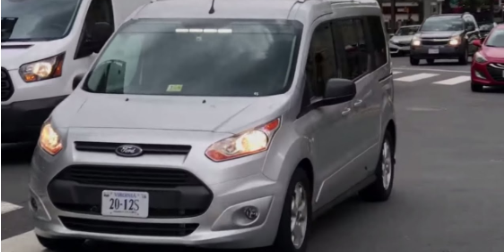http://1.bp.blogspot.com/-4cirxo5OmA8/WbvGR6e0kdI/AAAAAAAACWk/BTZj0I-smH01gRuLKKF16sbD7Q-TzeWTwCK4BGAYYCw/s1600/2017-09-15_17-51-48.png

In early August residents of Arlington, Virginia, spotted an unmarked silver Ford Transit van cruising around town without a human behind the wheel.
Local news publication ARLnow caught the ghostly vehicle on camera and speculated that it was part of Virginia Tech’s autonomous driving research. A couple of days later, NBC reporter Adam Tuss approached the vehicle on foot and peered inside, only to see hands poking out from the driver’s seat holding the steering wheel. The “driverless” car had a driver – but he was disguised as a car seat.
The “seat suit” stunt was the brainchild of Ford and Virginia Tech Transportation Institute research exploring how self-driving vehicles can communicate their intent to pedestrians, human drivers and cyclists.
There are so many subtle cues humans use to communicate with each other on the road that disappear when the driver is removed from the equation: eye contact to show a pedestrian they’ve been noticed, a head nod to let another driver take his or her turn at an intersection or a hand wave of appreciation when changing lanes in heavy traffic.
Ford and Virginia Tech wanted to test how people would react to light signals replacing some of this communication.
“We needed to try out this new lighting to communicate the intent of the vehicle, but if you’ve got a driver behind the seat you still have natural communication between humans like eye-to-eye contact,” said Andy Shaudt, who headed the research at Virginia Tech. “So we needed to make it look like a driverless car.”
That’s where the seat suit came into play. Shaudt’s team essentially created a false front for the driver’s seat matching the upholstery of the passenger seat. The driver would sit on the real seat and then cover his torso with a chest piece that snapped round the real seat with four magnets. He would then place a hood designed to look like the headrest (a black fabric screen over molded plastic) over his face.

“At first it was a little different and uncomfortable,” said Shaudt, who was one of six drivers to don the suit during August. “We first practised on a test track and got used to setting everything up and holding your hands down low [on the steering wheel].”
“Then you just pump up the air conditioning a little bit more and head out.”
Extensions on the indicator stalks allowed him to control signals with his hands held low and a control box strapped to his leg was used to control the experimental lighting signals which sent signals to passers-by.
“Some people are wary of this technology and if the vehicle is communicating its intent to them they may be more comfortable and accepting of the technology,” said Ford’s human factors technical specialist John Shutko who worked closely with Virginia Tech.
Shaudt and his team racked up more than 150 hours and 1,800 miles on the roads, with cameras capturing how other people reacted to the signals. The drivers were trained by Ford’s Argo AI autonomous car team in how to move the vehicle so it looked like a driverless car.
“They taught us not to accelerate or decelerate too quickly and obey all of the rules of the road, so stopping at stop bars and not going over the speed limit,” said Shaudt.
Being such sticklers to the rules could be frustrating for other drivers. In one case the car took a while to accelerate when a red light turned green.
“The car behind pulled up on the side and the driver started to yell ‘come on, get out of my way’ before stopping and saying ‘oh my gosh there’s nobody in that car!’,” said Shaudt.
Researchers gave the project the code name “Curtains”. “Because of the Wizard of Oz approach we used; the whole idea was ‘don’t look at the guy behind the curtains’,” said Shaudt.
The team has yet to go through all of the camera footage, but on the whole it went unnoticed – except by a few beady-eyed reporters.
“For the most part people are going about their day,” said Schaudt. There was some pointing and peering, but no mass outrage or attempts to sabotage or confuse the vehicle.
“Sometimes people would be looking at the the ‘seat’ but it would seem like they were looking right at your face even though they couldn’t see you. It was kind of awkward. You’d start smiling and then look away [because of the extended eye contact]. “But you didn’t need to – the hood was like one way glass.”
Barry Brown, a human-computer interaction researcher in Stockholm University, has been studying footage of autonomous or semi-autonomous vehicles made by Tesla, Google, Honda and Volvo to see how they handle social cues from human drivers.
He found that Teslas in autopilot can make lane changes in ways that would be considered rude by human drivers. In one case, the Tesla moves cuts in front of another vehicle that’s clearly accelerating into the gap.
“We like other drivers to be predictable. With Teslas sometimes they can change lanes in an unpredictable way. It’s not only seen as rude but can be dangerous,” said Brown.
“We’ve had 100 years of driving with other humans on the road to build up so many conventions and understandings,” he added. “Having machines that come in and don’t understand the subtleties of social interaction is going to be really difficult.”
guardian.co.uk © Guardian News & Media Limited 2010
Published via the Guardian News Feed plugin for WordPress.
Why did Ford build a 'fake driverless car' using a man dressed as a seat?https://goo.gl/LcwcTo











0 comments:
Post a Comment